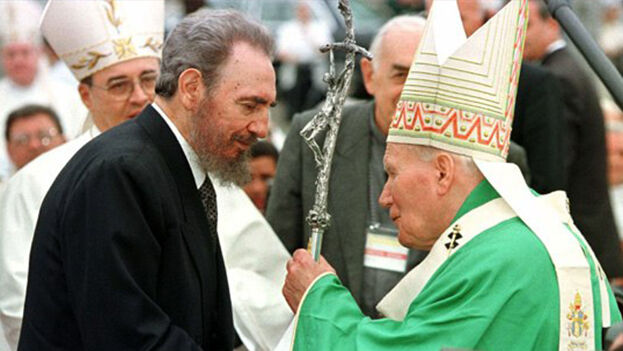
14ymedio, Pedro Corzo, Miami, 1 October 2022 — Although the leadership of the Revolution tried to give the insurrectional triumph a certain religious and humanistic aspect, very soon the belief in another superior being became the most feared enemy of the triumphant insurrection, along with proclaimed humanism, as green as palms.
Fidel Castro attacked religions in Cuba with ferocity, just as he did with homosexuals. He anointed himself as the paradigm to follow, he could not allow another religion that was not embodied in his person because, after all, Castroism is a form of mystical fundamentalism.
Church attendance dropped dramatically, as did membership in fraternal associations like Freemasonry. In Cuba a new religion was installed in which Fidel Castro was its God and “castrolicism,” as Gerardo Fundora described it, was truth revealed.
The regime then imposed values and norms that were inspired by Fidel’s beliefs and Marxism, following the dogma that “religion was the opium of the people.” Ethical foundations of society were thoroughly attacked, one of its most important objectives being religions in general, and the Catholic Church was a key target to destroy, in order to build the promised new order.
It was an indelible experience for believers who, in defense of their faith, were discriminated against, persecuted, humiliated, imprisoned and shot, as happened, among many others, with Alberto Tapia Ruano and Virgilio Campanería, who shouted “Viva Cristo Rey” before they died.
The regime-imposed values and norms that were inspired by Fidel’s thinking and Marxism, following the dogma that “religion was the opium of the people”
Verbal attacks against religions were very severe, among others, and Church-owned schools confiscated. Parishioners were systematically harassed, and those without deep faith buckled under pressure as a result.
Still, a significant number of the faithful, despite the fact that repression and discrimination became accentuated, maintained their religious commitment, as was the case of young Arnaldo Socorro, a native of Unión de Reyes, Matanzas, whose family moved to Havana during his adolescence.
Socorro had been awarded a scholarship to study at the Belén School, where he joined the Catholic Workers’ Youth. On September 10, 1961, he attended a procession with the image of the Blessed Virgin Mary, Our Lady of Charity of El Cobre, Patron Saint of Cuba.
The procession was set to start from the Church of La Caridad, under the guidance of the then auxiliary bishop of the Archdiocese of Havana, Monsignor Eduardo Boza Masvidal, one of the most courageous censors of the Castro regime, who was expelled from Cuba a week later with another 130 priests, by order of the hater by trade.
Arnaldo decided to participate in the religious procession that was undoubtedly an expression of rejection of the regime. When he arrived, he learned that the authorities had banned the procession, however, like thousands of people, he remained in front of the church to demand that his rights be respected.
The verbal attacks against religions were very severe, among others, confiscations of church-owned schools
Sheltered by an image of the Virgin, he marched at the head of hundreds of people who decided to follow him, shouting cheers to Christ the King, the Virgin and freedom, just as many of the young people shot by the dictatorship at that time shouted in front of the firing squad.
Socorro’s courage would not be respected by the regime and his henchmen. One of the enforcers, aware of his impunity, unloaded a machine gun into the young man, who fell mortally wounded.
He was 17 years old when he was assassinated, but, as journalist Julio Estorino sustains, “crime and outrage,” was added to the homicide by the regime, by proclaiming that the murdered young man was a revolutionary who had gone to the scene of the events to prevent an act of the “henchmen in cassocks,” as Castro identified Catholic priests.
The murder was blamed on Agnelio Blanco, a priest who was on the Isle of Pines at the time of the events, another cruel lie in Castro’s extensive defamation campaign against his critics. The evil did not end there. State Security officers went to Arnaldo Socorro’s house, threatened his family, buried him as a combatant killed by the counterrevolution and forged another martyr for the motherland.
____________
COLLABORATE WITH OUR WORK: The 14ymedio team is committed to practicing serious journalism that reflects Cuba’s reality in all its depth. Thank you for joining us on this long journey. We invite you to continue supporting us by becoming a member of 14ymedio now. Together we can continue transforming journalism in Cuba.
